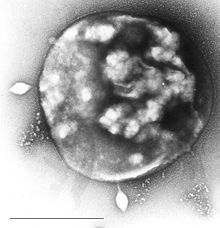| Thermoproteota | |
|---|---|

| |
| Archaea Sulfolobus infected with specific virus STSV-1. | |
| Scientific classification | |
| Domain: | Archaea |
| Kingdom: | Proteoarchaeota |
| Superphylum: | TACK group |
| Phylum: | Thermoproteota Garrity & Holt 2021[1] |
| Class | |
| |
| Synonyms | |
| |
The Thermoproteota are prokaryotes that have been classified as a phylum of the domain Archaea.[2][3][4] Initially, the Thermoproteota were thought to be sulfur-dependent extremophiles but recent studies have identified characteristic Thermoproteota environmental rRNA indicating the organisms may be the most abundant archaea in the marine environment.[5] Originally, they were separated from the other archaea based on rRNA sequences; other physiological features, such as lack of histones, have supported this division, although some crenarchaea were found to have histones.[6] Until 2005 all cultured Thermoproteota had been thermophilic or hyperthermophilic organisms, some of which have the ability to grow at up to 113 °C.[7] These organisms stain Gram negative and are morphologically diverse, having rod, cocci, filamentous and oddly-shaped cells.[8] Recent evidence shows that some members of the Thermoproteota are methanogens.
Thermoproteota were initially classified as a part of Regnum Eocyta in 1984,[9] but this classification has been discarded. The term "eocyte" now applies to either TACK (formerly Crenarchaeota) or to Thermoproteota.
- ^ Oren A, Garrity GM (2021). "Valid publication of the names of forty-two phyla of prokaryotes". Int J Syst Evol Microbiol. 71 (10): 5056. doi:10.1099/ijsem.0.005056. PMID 34694987. S2CID 239887308.
- ^ See the NCBI webpage on Crenarchaeota
- ^ C.Michael Hogan. 2010. Archaea. eds. E.Monosson & C.Cleveland, Encyclopedia of Earth. National Council for Science and the Environment, Washington DC.
- ^ Data extracted from the "NCBI taxonomy resources". National Center for Biotechnology Information. Retrieved 2007-03-19.
- ^ Madigan M; Martinko J, eds. (2005). Brock Biology of Microorganisms (11th ed.). Prentice Hall. ISBN 978-0-13-144329-7.
- ^ Cubonova L, Sandman K, Hallam SJ, Delong EF, Reeve JN (2005). "Histones in Crenarchaea". Journal of Bacteriology. 187 (15): 5482–5485. doi:10.1128/JB.187.15.5482-5485.2005. PMC 1196040. PMID 16030242.
- ^ Blochl E, Rachel R, Burggraf S, Hafenbradl D, Jannasch HW, Stetter KO (1997). "Pyrolobus fumarii, gen. and sp. nov., represents a novel group of archaea, extending the upper temperature limit for life to 113 °C". Extremophiles. 1 (1): 14–21. doi:10.1007/s007920050010. PMID 9680332. S2CID 29789667.
- ^ Garrity GM, Boone DR, eds. (2001). Bergey's Manual of Systematic Bacteriology Volume 1: The Archaea and the Deeply Branching and Phototrophic Bacteria (2nd ed.). Springer. ISBN 978-0-387-98771-2.
- ^ Cite error: The named reference
:0was invoked but never defined (see the help page).